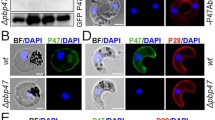Abstract.
Superoxide plays a crucial role in innate immunity to various pathogens. We examined the role of superoxides in the transmission of malaria using gp91phox knockout (X-CGD) mice that lack the ability to produce superoxide. Mosquitoes that fed on X-CGD mice infected intraperitoneally with Plasmodium berghei NK65 ANKA formed more oocysts than did those that fed on control mice at any day after infection. The number of oocysts peaked on day 5 post-infection in X-CGD and control mice and then decreased significantly after day 5 post-infection. However, on day 7 post-infection, the infectivity of gametocytes in X-CGD mice was significantly higher than that in control mice. These results show that two pathways, superoxide-dependent and -independent, are involved in the host systems regulating the transmission of malaria and inhibiting gametocyte development.
Similar content being viewed by others
Author information
Authors and Affiliations
Additional information
Electronic Publication
Rights and permissions
About this article
Cite this article
Harada, M., Owhashi, M., Suguri, S. et al. Superoxide-dependent and -independent pathways are involved in the transmission blocking of malaria. Parasitol Res 87, 605–608 (2001). https://doi.org/10.1007/s004360100432
Received:
Accepted:
Issue Date:
DOI: https://doi.org/10.1007/s004360100432




